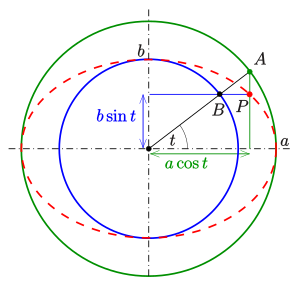Difference between revisions of "Equation of an Ellipse"
Jump to navigation
Jump to search
(Created page with "* [https://courses.lumenlearning.com/waymakercollegealgebra/chapter/equations-of-ellipses/ Equations of Ellipses], Lumen Learning") |
|||
| (3 intermediate revisions by one other user not shown) | |||
| Line 1: | Line 1: | ||
| + | [[Image:ElipseAnimada.gif|thumb]] | ||
| + | [[Image:Ellipse axis.png|thumb]] | ||
| + | |||
| + | ==Cartesian Equation of an Ellipse== | ||
| + | The general equation for an ellipse where its major, or longer, axis is horizontal is : <math>\frac{(x-h)^2}{a^2}+\frac{(y-k)^2}{b^2}=1</math>.<br /> | ||
| + | Where the major axis is vertical, it is: <math>\frac{(y-k)^2}{a^2}+\frac{(x-h)^2}{b^2}=1</math> | ||
| + | * The center is located at <math>(h,k)</math>. | ||
| + | * The foci are found at a distance of <math>c</math> from the centre along the major axis, where <math>c = \sqrt{a^2 - b^2}</math>. | ||
| + | * The eccentricity of the ellipse can be found from the formula: <math>b^2 = a^2(1-e^2)</math> where e is eccentricity. A higher eccentricity makes the curve appear more 'squashed', whereas an eccentricity of 0 makes the ellipse a circle. | ||
| + | * The directrices are the lines <math>x = \pm \frac{a}{e}</math> | ||
| + | * The major axis has a length of <math>2a</math> and the minor one <math>2b</math>. | ||
| + | * The sum of the distance from each point to each of the foci is <math>2a</math>. | ||
| + | |||
| + | == Parametric representation == | ||
| + | [[File:Elliko-sk.svg|thumb|The construction of points based on the parametric equation and the interpretation of parameter ''t'', which is due to de la Hire]] | ||
| + | |||
| + | ===Standard parametric representation=== | ||
| + | Using trigonometric functions, a parametric representation of the standard ellipse <math>\tfrac{x^2}{a^2}+\tfrac{y^2}{b^2} = 1</math> is: | ||
| + | : <math>(x,\, y) = (a \cos t,\, b \sin t),\ 0 \le t < 2\pi\ .</math> | ||
| + | |||
| + | The parameter ''t'' (called the ''eccentric anomaly'' in astronomy) is not the angle of <math>(x(t),y(t))</math> with the ''x''-axis, but has a geometric meaning due to Philippe de La Hire. | ||
| + | |||
| + | ===Rational representation=== | ||
| + | With the substitution <math display="inline">u = \tan\left(\frac{t}{2}\right)</math> and trigonometric formulae one obtains | ||
| + | :<math>\cos t = \frac{1 - u^2}{u^2 + 1}\ ,\quad \sin t = \frac{2u}{u^2 + 1}</math> | ||
| + | |||
| + | and the ''rational'' parametric equation of an ellipse | ||
| + | : <math>\begin{align} | ||
| + | x(u) &= a\frac{1 - u^2}{u^2 + 1} \\ | ||
| + | y(u) &= \frac{2bu}{u^2 + 1} | ||
| + | \end{align}\;,\quad -\infty < u < \infty\;,</math> | ||
| + | |||
| + | which covers any point of the ellipse <math>\tfrac{x^2}{a^2} + \tfrac{y^2}{b^2} = 1</math> except the left vertex <math>(-a,\, 0)</math>. | ||
| + | |||
| + | For <math>u \in [0,\, 1],</math> this formula represents the right upper quarter of the ellipse moving counter-clockwise with increasing <math>u.</math> The left vertex is the limit <math display="inline">\lim_{u \to \pm \infty} (x(u),\, y(u)) = (-a,\, 0)\;.</math> | ||
| + | |||
| + | ==Resources== | ||
* [https://courses.lumenlearning.com/waymakercollegealgebra/chapter/equations-of-ellipses/ Equations of Ellipses], Lumen Learning | * [https://courses.lumenlearning.com/waymakercollegealgebra/chapter/equations-of-ellipses/ Equations of Ellipses], Lumen Learning | ||
| + | |||
| + | == Licensing == | ||
| + | Content obtained and/or adapted from: | ||
| + | * [https://en.wikibooks.org/wiki/Conic_Sections/Ellipse Ellipse, Wikibooks: Conic Sections] under a CC BY-SA license | ||
| + | * [https://en.wikipedia.org/wiki/Ellipse Ellipse, Wikipedia] under a CC BY-SA license | ||
Latest revision as of 12:31, 14 November 2021
Contents
Cartesian Equation of an Ellipse
The general equation for an ellipse where its major, or longer, axis is horizontal is : .
Where the major axis is vertical, it is:
- The center is located at .
- The foci are found at a distance of from the centre along the major axis, where .
- The eccentricity of the ellipse can be found from the formula: where e is eccentricity. A higher eccentricity makes the curve appear more 'squashed', whereas an eccentricity of 0 makes the ellipse a circle.
- The directrices are the lines
- The major axis has a length of and the minor one .
- The sum of the distance from each point to each of the foci is .
Parametric representation
Standard parametric representation
Using trigonometric functions, a parametric representation of the standard ellipse is:
The parameter t (called the eccentric anomaly in astronomy) is not the angle of with the x-axis, but has a geometric meaning due to Philippe de La Hire.
Rational representation
With the substitution and trigonometric formulae one obtains
and the rational parametric equation of an ellipse
which covers any point of the ellipse except the left vertex .
For this formula represents the right upper quarter of the ellipse moving counter-clockwise with increasing The left vertex is the limit
Resources
- Equations of Ellipses, Lumen Learning
Licensing
Content obtained and/or adapted from:
- Ellipse, Wikibooks: Conic Sections under a CC BY-SA license
- Ellipse, Wikipedia under a CC BY-SA license



















![{\displaystyle u\in [0,\,1],}](https://wikimedia.org/api/rest_v1/media/math/render/svg/c61b780db9ac550dd283876e16abe9c2cccdf8c3)

